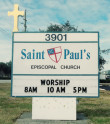Resurrection, not restoration
John 20:19-31

Sunday Sermon
the Rev. Jean Hite
Guest celebrant & preacher
Apr. 11, 2021
Alleluia – Christ is Risen!! (And you say . . . The Lord is risen, indeed! Alleluia!)
I’m so happy to be here this morning with you all celebrating this first Sunday after Easter! How
was your Easter celebration this year?
Actually, you know, we’ll be using that Easter greeting--Alleluia! Christ is Risen!--every
Sunday up until Pentecost on May 23. That’s because Easter is not just a day--it’s a season
that’s 50 days in length.
Easter is not a day, it’s a season . . . And resurrection is not a one-day event, it’s a process.
Resurrection is actually an ongoing, never-ending process, a cyclical process with an
ascending, spiral trajectory . . .
Given all that many of us are probably holding in our hearts right now, after what has been a
difficult year of pandemic woes – and given all that is happening in our world, it just may help to
know that resurrection is a process, not an event, . . . and helpful, also to remember that
resurrection begins in the dark.
We usually think of Easter as a time of joy. Christ is risen! Let us rejoice! However, the gospels
tell us that Jesus’ followers wake up on Easter morning in the dark – weighed down with
overwhelming grief. Something horrible, beyond their worst imaginations, has happened. There
is no joy in their hearts. . . fear, yes. anger, yes. Confusion and doubts, yes. . . . but no joy.
The Easter Gospels—all of them from Good Friday throughout the Easter season–give us
some powerful lessons on grief and confusion and doubt. Each of these stories begins with
people who are grieving, and not yet ready or able to believe.
Jesus’ disciples need time to process the news of his resurrection – to gather evidence that Jesus
really has been raised from the dead, to transition from a season of mourning into a season of
renewal and joy. Even those who had the chance to experience Jesus’ risen presence first hand
have trouble processing what they are encountering.
Unpacking the meaning of the resurrection is not an easy task for us, either. And there is nothing
surprising or unfaithful when we find ourselves wondering what this “Easter thing” really means.
In fact, the path to a deeper faith, I believe, lies in prayerfully wrestling with our questions in
search of understanding.
This Easter, our world is eager to break free of the social isolation of the past year and yet we
continue to be confined . . . locked in now for over a year of pandemic grief. So let’s look at
what the resurrected Jesus shows us, teaches us, about facing the journey through grief and
doubt.
In today’s gospel lesson, Jesus’ disciples are huddled together behind closed doors on the
evening of the first day, the day of Jesus’ resurrection. They’re afraid. That’s the most frequent
description of feelings and emotions on the first Easter – fear. The doors are locked for fear of
the Jews, the religious leaders. Fear – along with the grief and trauma of being disoriented –
being overwhelmed by loss – with shattered assumptions – and not knowing what will happen
next. Earlier this same day, Mary Magdalene had come to these disciples and said: “I have seen the
Lord.” But hearing the news isn’t enough. They need to be shown, not just told. So in the evening, Jesus himself, comes through the closed, locked doors. He stands among his friends and says: “Peace be with you.” Both his appearance and his words are consoling, encouraging, grace-filled gifts. “My peace, my wholeness, my shalom are yours.” Fear, grief and denial are suddenly overshadowed. They don’t matter as Jesus says: “I love you. . . Receive the Holy Spirit . . . Peace be with you.”
And then Jesus shows them his hands and his side. Jesus’ resurrection body has been transformed somehow, but the wounds remain. Jesus shows his wounds – and the disciples see and know the risen Lord. By these wounds, seeing and touching Jesus’ wounds, the disciples are healed. By this wounds WE are healed!
But Thomas didn’t see that; Thomas wasn’t there. And just hearing about it isn’t enough. He
doesn’t believe what the group tells him. Thomas – like all of us – needs a personal experience
of the risen Christ – in person, in the flesh. And Thomas boldly asks for more – for himself
and on behalf of all of us: “Unless I can put my finger in the mark of the nails and my hand in
his side . . . I will not believe.”
The next week when they are again gathered behind closed doors, Jesus shows up once more and
offers what Thomas needs – invites him to come close and touch. Touching Jesus’ wounds
changes Thomas. And he proclaims: “My Lord and my God.”
Resurrection doesn’t come as we expect. Resurrection comes amid tears – in locked rooms – to
people facing death and loss. If you or someone you know is entering this Eastertide in a season
of mourning, remember that God meets us where we are, whether at the foot of the cross or at the
door of the empty tomb. No trauma, no death, no grief can separate us from the love of God.
And God grants us the time to process, unpack, and heal from our pain. Throughout it all, God
promises to abide with us as we emerge from our seasons of sorrow.
I mentioned earlier that it can be helpful, especially this year, to remember that Easter is not a
day, it’s a season – and that it’s not a one-day event, it’s an ongoing process. Remember also,
that Easter is not about restoration, it’s about resurrection!
When the disciples encounter Jesus after his resurrection, he has a new body; it has some
similarities to his old one, but it is radically different. His new body has connections with the
past – but is firmly grounded in the future. The resurrected Jesus gives his followers a foretaste
of what they will experience when they too receive new bodies.
Likewise for us in what lies ahead. Life after this pandemic will be different than it was before.
The “getting back to normal” that we all have been longing for – it will be a new normal. We
are already seeing the signs! So in the days ahead, remember that we will be experiencing
resurrection ... it won’t be restoration.
In Revelation 21:5, the one who is seated on the throne says, “See, I am making all things new.”
God’s resurrection, God’s re-creation, is an ongoing process. . . and the Good News of Jesus’
resurrection continues. It will be resurrection! that will sustain us . . . comfort us . . .and heal us
– in the days and months ahead.
Amen.
SUPPORT ST. PAUL'S DONATE NOW OR RECURRING DONATION

3901 Davis Blvd., Naples, Florida 34104 239-643-0197 Office hours 9 a.m. to 1 p.m. Monday-Friday


